
by Gianluca Arnone
«It’s not just about putting one foot in front of the other, but about going through oneself». So states Chery, the protagonist of Wild, echoing Saint Augustine: «Pilgrimage is a return to the heart». Whether it is a spiritual itinerary or a path of transformation, the journey inevitably carries with it a series of symbolic refrains that make it one of the most quintessential speculative themes. In the case of women, this experience acquires an additional significance, for it is not only a journey of faith or self-discovery but also a form of emancipation from the constraints imposed by society.
A female pilgrimage continues to be a powerful metaphor for the search for self and one’s own voice in the world. Cinema has effectively portrayed this path. Though There Will Come A Day (2013) by Giorgio Diritti and Wild (2014) by Jean-Marc Vallée tell different stories they share the same desire for transformation. The latter is based on the memoir of the same name in which Cheryl Strayed recounts her solitary journey along the Pacific Crest Trail, a path that in the film becomes a symbol of the need to overcome the pain of loss and self-destruction. Performed by Reese Witherspoon, she embodies a modern heroine who confronts nature and her own physical and psychological limits, and finds the strength to face her past and rebuild her life.
Similarly, There Will Come A Day depicts the pilgrimage of Augusta (Jasmine Trinca), a young woman who, after experiencing deep pain, chooses to distance herself from Western society to seek refuge in the Amazon. Her journey is both an escape and a search. While immersed in a completely new context, Augusta experiences a form of spirituality that is different from her Christian origins and she finds herself confronted with a new vision of life and faith. This experience challenges the stereotypes of female journeys as romantic escapes. Their pilgrimages are tests of endurance, acts of rebellion, and ultimately instruments of rebirth. Even in Church history, female pilgrims often challenged conventions. Saint Bridget of Sweden, in the 14th century, left court life to travel to Jerusalem, while Margery Kempe wrote the first mystical autobiography in English, and narrated her pilgrimage as an act of disobedience to marital expectations. This tension between obedience and rebellion also appears in Tracks (2013), where Robyn Davidson crosses the Australian desert with her camels in a secular pilgrimage that is nonetheless sacred.
In Holy Smoke! (1999) by Jane Campion the director completely changes perspective, by outlining a genuine theology of the female journey in cinema. Here, the physical and spiritual path becomes an act of liberation but also a confrontation with patriarchal structures, which are both secular and religious. A remarkable Kate Winslet plays Ruth, a young woman who, after a mystical experience in India, which her family (and Western society) interprets as a threat, is “re-educated” by a deprogrammer (Harvey Keitel). Her “conversion” is not accepted, and she is subjected to a kind of secular exorcism. Similarly, in There Will Come a Day, Augusta flees to the Amazon after a trauma, where she seeking a more authentic spirituality, which is distant from the hypocrisies of Western society. Her journey recalls that of missionaries, but with one difference: she does not go to convert, but to be converted. Like Ruth, Augusta seeks God (or at least meaning) outside institutions, in a wild spirituality that Christian tradition has often viewed with suspicion. In both films, the woman’s body becomes a battleground between opposing forces: in Holy Smoke!, Ruth uses her sensuality as a weapon to overturn roles. In There Will Come A Day, Augusta immerses herself in a primitive world where the body is no longer an object of judgment but a tool for survival and prayer. And while in Christian tradition pilgrimage is an act of obedience (going to Santiago, Rome, or the Holy Land to affirm one’s faith), in these films it becomes an act of disobedience. The female journey in cinema is often a heresy, in the etymological sense of the word (hairesis, “choice”). The protagonists choose their own path, even if it leads them outside society, the Church, and expectations. Yet, just like the medieval mystics, they find God (or at least themselves) only by stepping outside the rules.




 Purchase the Encyclical here Fratelli Tutti
Purchase the Encyclical here Fratelli Tutti